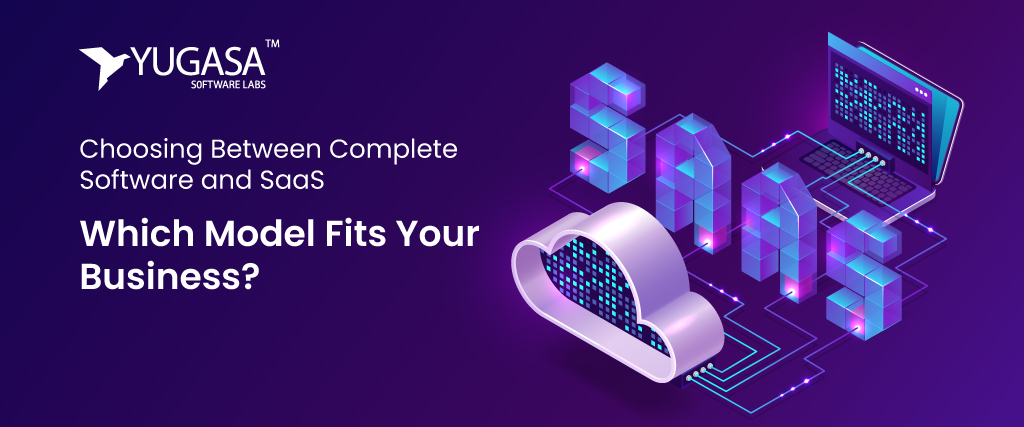Ultimate Guide: Choose the Best Software or SaaS Model for Success!

In the dynamic realm of modern business operations, selecting the right software model is a pivotal decision that can significantly impact organizational efficiency, flexibility, and financial planning. Two primary options businesses often consider are traditional complete software and the increasingly popular Software-as-a-Service (SaaS) model.
Each model offers distinct advantages that cater to varying business needs and operational goals, making it essential for decision-makers to carefully evaluate their specific requirements before committing to a solution. Understanding the nuances and benefits of both approaches is crucial for businesses seeking to optimize their software investments in alignment with their strategic objectives and growth trajectory.
Benefits of Buying Complete Software
1. Ownership and Control:
Purchasing complete software grants businesses full ownership and control over the application. This autonomy allows organizations to customize the software extensively, tailoring it precisely to their operational needs and preferences. From user interface adjustments to backend configurations, businesses can optimize the software to enhance productivity and efficiency across different departments.
2. One-Time Cost:
Complete software typically involves a one-time upfront cost rather than ongoing subscription fees. This financial structure can be advantageous for businesses looking to manage their budgets effectively and avoid the uncertainty of fluctuating subscription rates. By making a single investment, organizations can allocate resources more efficiently and plan for long-term operational expenses without the burden of recurring payments.
3. Security:
Complete software solutions often provide robust security features, offering businesses enhanced control over data protection measures. Organizations can implement stringent security protocols tailored to their specific requirements, reducing vulnerabilities and safeguarding sensitive information from unauthorized access or breaches. This level of control is particularly critical for industries handling confidential data or operating in regulated environments, where compliance with stringent security standards is paramount.
4. Customization and Integration:
Complete software allows for extensive customization and seamless integration with existing systems. Businesses can tailor the software to align perfectly with their unique workflows and operational processes, maximizing usability and efficiency. This customization capability enables organizations to adapt quickly to evolving business needs, scale operations effectively, and maintain competitive advantage in their respective markets.
Why the SaaS Model is Revolutionizing Business Operations
1. Cost Efficiency:
SaaS operates on a subscription basis, offering lower initial investment and predictable monthly or annual expenses. This affordability makes it accessible for businesses of all sizes, especially startups and SMBs.
2. Scalability:
SaaS solutions are highly scalable, allowing businesses to easily adjust resources based on fluctuating demands. This flexibility eliminates the need for substantial upfront investments in hardware or software upgrades.
3. Accessibility:
Accessing SaaS applications requires only an internet connection, enabling remote and distributed workforces to collaborate seamlessly. This accessibility supports modern work environments and enhances operational efficiency.
4. Maintenance and Updates:
SaaS providers handle software maintenance and updates automatically. This relieves the burden on internal IT teams, ensuring businesses always have access to the latest features and security patches without downtime.
5. Rapid Deployment:
Deployment of SaaS solutions is rapid compared to on-premise software, speeding up implementation and reducing time-to-value for businesses. This agility is critical for companies aiming to innovate and adapt quickly in competitive markets.
Intellectual Property Rights
When considering software models, it's crucial to understand intellectual property (IP) rights. With complete software, the customer typically owns the IP rights of the platform, allowing for greater control and customization. In contrast, in the SaaS business model, the IP rights usually remain with the providing company. This distinction can influence a business's decision, particularly if owning the IP rights is critical for their strategic objectives.
FAQs
What factors should I consider when deciding between complete software and SaaS?
Considerations include your budget, need for customization, scalability requirements, security concerns, and long-term operational goals.
Is complete software or SaaS more cost-effective for my business?
Complete software often requires a larger upfront investment but avoids recurring subscription fees. SaaS, on the other hand, offers lower initial costs but ongoing subscription payments.
How does ownership differ between complete software and SaaS?
Complete software grants full ownership, allowing businesses to control customization, security measures, and integration with other systems. SaaS typically provides access rather than ownership, with the provider managing updates and maintenance.
Which model is more scalable as my business grows?
Fixed price projects are preferred because you may need more custom features and scalability of your digital platform as per your business demands. This becomes a challenge if such new feature development is not in the work pipeline of the SaaS providers.
What are the security implications of each software model?
Complete software offers businesses greater control over data security measures, making it suitable for industries with strict compliance requirements. SaaS providers manage security protocols and updates centrally, often with robust measures to protect data.
Conclusion
Choosing between complete software and the SaaS model hinges on understanding your business's specific needs, budget constraints, and growth objectives. While complete software offers ownership and control, SaaS provides cost efficiency, scalability, accessibility, and streamlined maintenance. Ultimately, the decision between complete software and SaaS should align with your company's overall strategy to leverage technology effectively and sustainably in today's competitive landscape. Consider your specific needs for customization, scalability, security, and budgetary constraints when evaluating these models. By choosing the right software model, you can enhance operational efficiency, support business growth, and maintain a competitive edge in your industry.
Ready to choose the best software model for your business? Contact us today to discuss how we can help you navigate this decision and optimize your technology investments for success.
